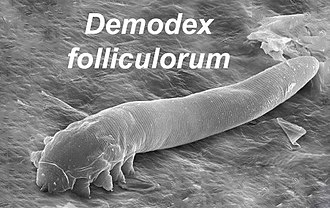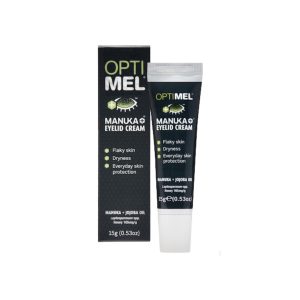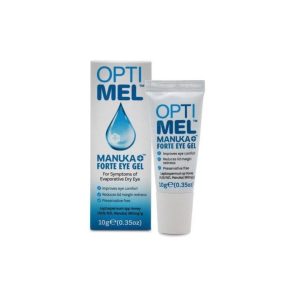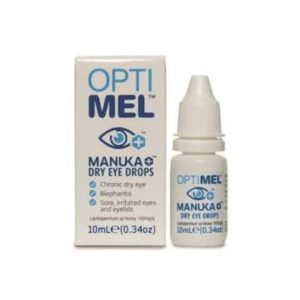Are you experiencing ongoing dryness, irritation, or discomfort in your eyes? If you answered yes, you may be among the many individuals dealing with chronic dry eye syndrome, which can be closely associated with an overpopulation of Demodex mites. These tiny, eight-legged creatures are a natural component of the human skin biome, particularly prevalent around the delicate eye and eyelid areas. However, when their numbers increase excessively, they can instigate inflammation and exacerbate the symptoms of dry eye syndrome, resulting in considerable discomfort and distress.
If you have been struggling with ongoing unexplained dry eye symptoms, it’s crucial to assess whether Demodex mites could be a significant contributor to your issues. In this comprehensive guide, we will help you identify the signs of a potential Demodex infestation, clarify the connection between these mites and dry eye disease, and provide a range of effective treatment options aimed at managing their population while alleviating your discomfort.

Recognizing the Distinct Symptoms of Demodex Blepharitis
Individuals suffering from Demodex Blepharitis or an excessive presence of these mites frequently experience a range of specific symptoms. Common manifestations include:
- Burning, stinging, or gritty sensations in the eyes, especially noticeable towards the latter part of the day.
- Unexpected excessive tearing or watery eyes that are not attributable to allergies.
- Red, inflamed eyelids, along with irritation of the skin surrounding the eyes.
- Crusty, dandruff-like buildup along the lashes and lid margins, often presenting as collarettes.
- Heightened sensitivity to light, creating an ongoing feeling of squinting.
- Fluctuating episodes of blurred vision occurring throughout the day.
Many individuals endure these dry eye symptoms for extended periods without realizing that an infestation of Demodex mites could be a significant underlying factor. Recognizing these symptoms is an essential step in effectively addressing the core issue and restoring comfort.

Understanding How Demodex Mites Cause Dry Eye Symptoms
Are you curious about how these minuscule organisms can lead to distressing dry eye symptoms? Demodex mites thrive on the oils and cellular debris present on the skin, particularly within the hair follicles of your eyelashes. As they feed on these materials, they leave behind waste products, eggs, and the remnants of deceased mites, which accumulate along the delicate lid margins. This buildup creates a thick layer of debris and a bacterial biofilm, which can obstruct the essential oil glands that are crucial for maintaining optimal eye health.
When these oil glands are unable to release adequate oils, it results in the swift formation of dry patches on the surface of the eye. This oily tear film is vital for preventing the rapid evaporation of the watery tears that are necessary for keeping our eyes moist and comfortable. The inflammation triggered by the blockage can further intensify eye irritation, redness, and the uncomfortable gritty sensations that are commonly associated with dry eye conditions.
Exploring the Life Cycle of Demodex Mites for Effective Treatment
Gaining insight into the life cycle of Demodex mites is essential for implementing effective treatment strategies. These mites progress through distinct stages: egg, larva, nymph, and adult, over a life span of approximately 14 to 21 days. Notably, they are most active during the night, emerging from their hair follicles to mate and lay new eggs on the surface of the skin.
This nocturnal behavior suggests that the optimal time to apply Demodex treatments is during the evening, just before bedtime. By targeting the mites at their peak activity, you can significantly enhance the effectiveness of your treatment regimen. However, due to their rapid reproductive capabilities, any surviving mites can quickly repopulate, making ongoing treatment crucial over several weeks or even months to achieve lasting relief.
Effective Strategies for Managing Demodex-Related Dry Eye Symptoms
If your optometrist confirms a high population of Demodex mites through eyelash sampling or microscopic examination, they may recommend a variety of treatment options designed to combat the infestation:
1. Harnessing Tea Tree Oil Eyelid Wipes and Scrubs for Optimal Relief
Products infused with tea tree oil are renowned for their potent antimicrobial and antiparasitic properties, making them incredibly effective in eliminating these mites. These formulations can help eradicate surface mites, break down the collarettes formed by these pests, and assist in drawing out hidden mites, rendering them more susceptible to treatment.
While tea tree oil is effective against mites, it can cause a stinging sensation upon application and may be cytotoxic to healthy cells, potentially inflaming and aggravating symptoms for certain patients. Regularly using tea tree oil eyelid wipes or scrubs before bedtime can gradually reduce the mite population over time. A noteworthy example of a powerful tea tree oil treatment is OcuSoft Oust Foam, which is particularly effective in managing blepharitis primarily attributed to Demodex mites.
2. Utilizing Gentle Hypochlorous Acid Lid Hygiene Sprays for Safe Eye Care
Hypochlorous acid is a naturally occurring substance produced by our immune system and serves as an effective antimicrobial agent. It is gentle on the eyes, does not cause stinging, and is safe for our cells. Disinfecting lid sprays and cleansing foams containing hypochlorous acid not only eliminate mites but also help reduce inflammation while providing relief from associated symptoms.
Applying these solutions to the lash lines before bed can effectively eradicate mites and their accumulated debris. Many of these products have a distinct odor reminiscent of chlorinated pool water. Popular hypochlorous acid-based solutions include Ocusoft Hypochlor Spray and Avenova. Among these options, Ocusoft Hypochlor Foam is often recommended due to its superior value and extended shelf life after opening, making it a practical choice for ongoing management.
3. Exploring the Benefits of Manuka Honey Solutions for Eye Health
Recent research suggests that Manuka Honey solutions may demonstrate efficacy comparable to 50% tea tree oil against Demodex, although further studies are warranted in this area. While it may induce a slight sting upon application, Manuka Honey is generally less irritating than tea tree oil and shows excellent effectiveness against various forms of blepharitis. It is non-cytotoxic and less likely to provoke inflammation in the eyelids.
Many patients report that any initial sting is well worth it, as they frequently experience significant relief afterward. Manuka Honey solutions are available in gel form (such as Optimel Forte, which is more effective but may sting more) as well as drops (like Optimel Drops, which are easier to apply and sting less).
4. Addressing Severe Demodex Infestations with Oral Anti-Parasitics
In cases where Demodex overpopulation is severe and persistent, healthcare professionals may consider prescribing oral antiparasitic medications. For instance, formulations such as Ivermectin in pill form have proven effective in managing these infestations. Furthermore, taking weekly doses of oral tea tree oil supplements over several months can help to maintain mite levels in check and provide longer-lasting relief from symptoms.
5. Exploring Professional Treatments for Advanced Demodex Management
Some specialized eye clinics offer intensive in-office treatments specifically designed for Demodex management, utilizing specialized products such as Oust Demodex Cleanser Swabstix or a hand-held electric brush known as BlephEx. The Oust Demodex Cleanser Swabstix provides targeted treatment options that can effectively assist in alleviating the impact of these troublesome mites.
The Article: Demodex Mites Linked to Chronic Dry Eye Issues first appeared on https://writebuff.com.
The Article Demodex Mites and Their Connection to Chronic Dry Eye Was Found On https://limitsofstrategy.com





Your exploration of chronic dry eye syndrome and its potential link to Demodex mites provides important insights into a condition that affects many individuals yet often goes under-discussed. It’s fascinating how components of our own microbiome, like these mites, can play such a significant role in our health, transforming from harmless inhabitants to potential disruptors when their populations exceed normal levels.
It’s fascinating how often we overlook the microscopic world that inhabits our bodies, and this blog post sheds light on an issue that many may experience but few understand—chronic dry eye syndrome. I have to admit, I used to think of dryness in the eyes as just an inconvenience, perhaps related to screen time or allergies. However, the connection between Demodex mites and eye discomfort is eye-opening.
It really is surprising how much we take for granted our own bodies, isn’t it? The connection between our microcosmic inhabitants, like Demodex mites, and chronic conditions like dry eye syndrome is something not many of us think about. I used to see dry eyes similarly—as just a sign I’d been staring at screens too long or maybe due to seasonal allergies. It wasn’t until I delved deeper into the topic that I realized how complex these issues can be.
You bring up such a good point about how we often overlook the intricate workings of our bodies. It’s easy to dismiss things like dry eyes, especially with our modern lifestyles that have us glued to screens for hours. I used to think the same way, attributing my dry eyes to long workdays or that pesky seasonal pollen. But once I started reading into it, I realized that our bodies host a whole ecosystem of tiny organisms that impact our health in ways we don’t fully understand.
This topic resonates deeply with me, as I’ve struggled with similar dry eye issues for years. It’s fascinating (and a bit unsettling) to think that something as small as Demodex mites could play a crucial role in our eye health. I once read about how our skin microbiome interacts with various conditions, and it made me realize that the balance of these tiny organisms can really affect our overall wellness.
It’s wild, right? Who knew that such tiny critters could be running the show with our eye health? It’s like having uninvited house guests hanging out on your eyelids, and they’re not even bringing a snack. The skin microbiome is like that intricate social network we all wish we could manage better. Just a few unwelcome guests and suddenly the whole party takes a turn for the worse.